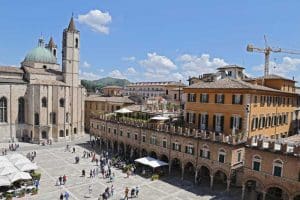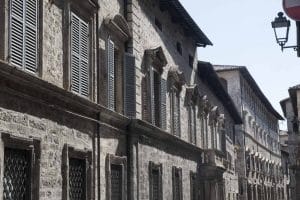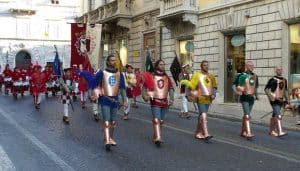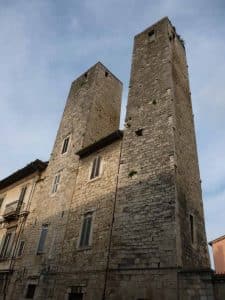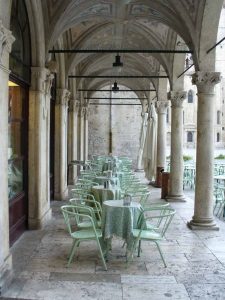This article originally appeared in the August/September 2021 issue of Dream of Italy. Members receive access to nearly 190 back issues—if you’re not a member, join here. The writer of this article, Valerie Fortney, won an award from the International Food Wine Travel Writers Association for this piece!
With Renaissance palazzi, art-festooned churches, more towers than San Gimignano and a piazza heralded as one of Italy’s most beautiful, Ascoli Piceno lacks nothing, except for crowds. The provincial city in southern Le Marche may be little-known, but its travertine splendor and aura of elegance make a big, eye-popping first impression.
The well-preserved centro storico is classy, but also loved and lived-in by its residents—a playground, workspace, open air museum, marketplace and gathering spot all at once. Ascoli Piceno sits just a few miles from the Abruzzo border, along the ancient Roman road Via Salaria, and is cradled in a valley between the Tronto River and Castellana stream, making it easy to get around on foot or bike. Or take the easy route to hit the highlights by hopping aboard the trenino tram tour that chugs around the old town for a quick overview.
More Ancient Than Rome
The Ascolani proudly proclaim to anyone who will listen that Ascoli e più antica di Roma—Ascoli is more ancient than Rome. They’re right, of course. The city and surrounding area had a thriving civilization populated by the Piceni people, who controlled much of what is now Le Marche and northern Abruzzo from the 11th to the third centuries BC, long before Rome was founded. It was the Romans, however, who gave the city its first dose of prosperity and much of its current street plan.
The core of the centro storico still lines up with the original Roman grid-like streets, but there is enough influence from the Middle Ages to offer lots of intriguing narrow alleyways to delight the senses as you wander around. (You can also pick out Roman inscriptions in the medieval buildings, as the Romans scavenged the blocks and columns from the Roman amphitheater, teatro and forum.)
The entire city is built in travertine stone, giving Ascoli Piceno such a uniform and stately appearance that it looks downright refined. Grandiose palaces and civic buildings, Romanesque churches, and looming towers were all constructed in the stone. Those towers were all the rage in the Middle Ages.
Ascoli is called the “city of a hundred towers,” though in its prime the skyline positively bristled like a stone forest with 200 skyward-reaching towers. That was, until 1242 when Frederick II ordered half of them to be cut down. Others were turned into bell towers or shortened, or incorporated into surrounded buildings, so about 50 are discernible today. The most impressive are found in the northwestern part of the old town.
The entire city is delightful to wander, with lots of details to take in. Here are some of the highlights:
La Bellissima Piazza del Popolo
Start your visit to Ascoli off with a bang in the magnificent Piazza del Popolo and you’ll easily see why even Italian visitors stop in their tracks and gasp. The Renaissance square is equally dazzling in the sunlight and moonlight, as each plays differently on the smooth, shiny travertine and colonnades. It’s also the heart of Ascoli’s nightly passeggiata, and is the town’s greatest gathering spot. It’s the scene of the raucous Carnevale festivities, a monthly antiques market and summer concerts and open-air operas.
The impressive Palazzo dei Capitani dominates the west end, frequently hosting art exhibits or special events. Dash inside to see the lovely three-tiered courtyard of loggias. Next to the entrance is a door leading down to Roman ruins below.
The piazza‘s appearance remains unchanged from the Renaissance era, with the distinct exception of Caffè Meletti, originally built as a post office in 1880. It remains the city’s most popular and posh place to meet for drinks. The house specialty is their Meletti anisetta, a great after-dinner liqueur or a “corrective” in coffee. All the fixtures and seating are original, installed when Silvio Meletti opened the café in 1903.
The monumental Church of San Francesco flanks the piazza’s north side, giving the square a stately skyline of two towering belfries and dome. Started in 1258, the massive church wasn’t finished until 1549, and if you look closely you can see slight color variations in the stone indicating the different periods of construction. The elaborate Gothic entrance bears elegantly carved travertine; some looks delicate and lace-like, and other pieces are solid roaring lions or graceful columns. The interior is austere, but the stained-glass windows tell tales, including some that portray recent events like the Nazi occupation during World War II.
The church has two anomalies. Near the main door are quirky columns that look like organ pipes. They’re the “singing columns,” worn smooth from generations of Ascolani who make them chime by hitting them with their hands; give it a try. Another is under the loggia, a tablet that bears the exact dimensions for all the tiles and bricks used in constructing the church, a handy template erected in 1569 for future repairs.
A Road of Palazzi
Corso Mazzini slices through town from west to east and is littered with loads of splashy Renaissance-era palaces, some sedate and some festooned with adornments. Take a stroll to see the styles and the details. Some of the most grandiose are in the eastern flank of the street, where carved angels, and decorative windows and portals, are the norm.
Palazzo Malaspina is one of the most impressive, built by a powerful wool merchant family. Stand across the street and look up at the loggia above, where the pillars are carved to resemble tree trunks. Another anomaly: The carved notch in the cornerstone is reputed to have been the owner’s punishment for murder. (He surely learned his lesson from that stiff penalty!)
The Talking Walls
A unique feature around here are the “walls that speak,” so be on the lookout for the inscriptions as you meander the medieval streets. There are dozens of mottoes and maxims engraved above the doorways, a fad here in the Middle Ages, with some in Latin and some in vernacular. A few are whimsical, while others are ironic or exude pearls of wisdom. For example: “It is difficult to be liked by many.” And, “Not without fatigue.” Another: “Sit not on the stoop.”
Piazza Arringo
More sedate than Piazza del Popolo but no less used and enjoyed, its focal point is the dominating Duomo and next-door temple-like octagonal Baptistry. The Roman forum was located here, and like that ancient space, Piazza Arringo still serves the city’s religious, political, cultural and commercial functions. Flanking the south side is the Palazzo dell’Arengo, the town hall, while two beloved fountains playfully spurt water in front of it, where young and old alike take turns drinking from the bronze seahorses.
The palazzo is home to a fine art museum, while the arch next to the cathedral leads to the Diocesan Museum with sacred art. Across the piazza is the Archeology Museum, well worth a look for the Piceni and Roman artifacts, including marvelous mosaics.
The cathedral’s austere façade doesn’t prepare you for the artistic splendor within, so step inside and feast your eyes on the resplendent, vibrant frescoes; scalloped bays; and lines of columns, each capped with a differently carved capital. The side chapel, Cappella del Santo Sacramento, holds a glorious polyptych by Venetian painter Carlo Crivelli, still in its original frame and setting, a masterpiece that still inspires the Ascolani. You see, the costumes for La Quintana are authentically tailored using Crivelli’s renderings of period dress.
La Quintana (www.quintanadiascoli.it) is an annual Palio event that pits the six sestiere of Ascoli against each other for bragging rights and the prized Palio drape. They compete in archery, flag throwing and more, but it all culminates in the rousing joust, a high-energy beloved horse race, which is preceded by an opulent parade in period costumes by representatives of each district. Plan your visit in July or August to see it.
Do go downstairs to the crypt with its forest of columns and Roman ruins, along with a memorial to Sant’Emidio, who is the city’s patron saint and protector against destructive earthquakes.
The City Gates
Ascoli Piceno retains many of its ancient gates intact, each different and beautiful in its own way. The entry points to the city from each direction would have been closed at night and in times of peril. Porta Gemina and Porta Romana nest next to other on the western side of the old town, the ancient Roman gate and the “newer” medieval one. Parts of the walls were destroyed to make room for cars, but they’re still lovely. Just inside the walls to the right are the remains of the Roman theater.
Porta Tufila is along the Tronto on the north side, maybe the most decorative with its triple-arcade loggia above the single archway below, and is especially pretty at night. The southern gate, Porta Catara, is no more, but the bridge that fed through it was actually an aqueduct, the upper part of which was destroyed by the Germans in WWII. Look down below the bridge road surface and you can see the aqueduct arches. Porta Solestà is at the beginning of the Ponte Romano bridge leading across the river and the oldest gate. The bridge, incidentally, was built by Emperor Augustus and hides a secret passageway inside.
Cross the Bridge
The ancient bridge Ponte Romano (also called Ponte Augusteo) was the only one not bombed by the retreating German forces during WWII. Pass under the Solestà Gate and venture across the bridge to gaze back across on one of the best views of medieval Ascoli Piceno and its towers.
The panoramic vantage point gives you the ancient gate, several of the stone towers, and beyond the city, Colle San Marco, the hill that skirts the border with Abruzzo. On the Solestà side of the bridge is the old lavatoio, the antique washing basins; this particular one is also said to have been the spring where patron saint Emidio baptized many converts.
Twin Towers and More
A pair of medieval towers is naturally dubbed “le torri gemelle” or the twin towers, so head to Piazza Sant’Agostino to view the duo of medieval skyscrapers, that are among the easiest to find—and photograph. One leans noticeably. While you’re here, pop inside the Church of Sant’Agostino, which holds the beloved Madonna della Pace (Madonna of Peace), a much-venerated 14th-century painting of a breastfeeding Mary that has continually mediated peaceful resolutions among factions and families through the centuries.
The street is conveniently called Via delle Torri, so walk down it towards the river until it ends and veer left onto Via dei Soderini, where you will see the tallest towers in town. Called the Ercolani Tower, it’s the most intriguing, too, as together with the attached Palazzo Longobardo, they form a fine and unaltered example of how the wealthy constructed their homes and accompanying status-symbol towers.
It’s one of the best-preserved examples of medieval architecture in the province. Note the interesting triangles above the doors, which some say were Templar symbols (others hold they were just to disperse the weight). Across the street is another tower.
A stroll through this district yields lots of pretty corners and details, and some of those cut-down towers, if you keep your eyes open.
Café Scene
This place is teeming with cool cafés that will make you want to sit and people watch while enjoying a glass of local vino or a caffè and pastry. The grand dame is deco-styled Caffè Meletti, which is a must at least once for coffee, aperitif, or an after-dinner anisetta. Besides the frescoed portico, elegant arches and luscious interior, at Meletti even the bathrooms are special, as they contain Roman ruins encased below the glass vanity sinks!
But there are trendy contemporary-styled wine bars on both piazzas, and homey old-timers, too, like Bar Centrale, a stalwart that still attracts the elderly gents for a game of scopa, and a daily round of regulars for their morning caffè and evening beer or vino. Around the corner is Caffè Sestili, an historic locale that has been restyled but still serves pretty pastries, a good selection of teas, wine with nice tidbits and light lunches.
Facing Piazza Roma, the unassuming sign just says “Bar,” but step inside the Latteria Marini and indulge in a decadent dollop of whipped cream on a thick, fudgey hot chocolate or caffè Viennese. Known for their dairy goods, another treat is a maritozzi, a sweet roll filled with whipped cream. If your taste runs to chocolate, then get thee to Yoghi on Piazza Arringo, where the gelati and homemade candies are chocolate heaven.
Ascoli Olives and Fritto Misto
What’s not to love about a giant olive that is stuffed with meat and deep-fried? The premise of olive all’ascolana sounds like a strange, not-very-Italian specialty, but it is the beloved contribution of Ascoli Piceno to the culinary world. They use the ascolana variety of olives, grown in the hills outside the city, hand-carve the fruit from the pit, then wrap it around a mix of savory meats.
They’re definitely addictive, and the kick-off to every celebration in Ascoli, from birthdays to baptisms and every holiday of the year. Give them a taste. They go alongside the other fried fare, such as the cremini—custard that is battered. Strange but good. They also serve up a fritto misto, or mixed fry, as a main dish that pairs meat like lamb chops with zucchini and artichokes, all fried, of course. The city hosts an annual summer festival dedicated to fritto misto that brings in hungry foodies from all over the world. If you want to make your own, find a family recipe in the June/July 2019 issue of Dream of Italy.
It is easy to stop at the piazza-side stand in Piazza Arringo, but as their olive (oh-LEE-vay) are made in a factory, I recommend moving on and getting a cone of them at the hole-in-the-wall shop in Piazza del Popolo, called 180 Gradi. Another good choice is Siamo Fritti (Piazza Simonetti, 87), a cute wine bar and (what else?!) fried food paradise, just around the corner from Piazza del Popolo. Every restaurant in town serves them up, too.
These highlights barely scratch the surface of the bellezze and attractions here. Spend a few days and you will surely be hooked on awesome Ascoli Piceno.
—Valerie Fortney
Valerie Fortney returned to her roots in the region of Basilicata, where she is a freelance writer and professional genealogist. She’s the author of the book 52 Things to Do in Basilicata. For more on Valerie and her work, visit www.mybellabasilicata.com
Where to Stay
Albergo Sant’Emidio offers the perfect location on a quiet lane just three steps off the Piazza Arringo in the heart of Ascoli, close to everything but tranquil and restful. All 21 rooms have fluffy towels, comfortable beds and air conditioning with muted but pretty décor. Some rooms come with terraces, and some have jet tubs to soothe the sore muscles after walking around town. Rates for a double room start at 65€ a night, with breakfast. (39) 0736 258626; www.albergosantemidio.it
In the medieval streets of town mingled among the towers, the Hotel Residenza Cento Torri is a four-star property in a beautifully renovated building with one of those pared-down towers. It’s a quieter part of town but an easy walk to everything and rooms are beautifully appointed with wood floors, wood-beamed ceilings and period charm. You can also enjoy all the modern comforts and amenities you want, including a pillow menu and air conditioning. There’s also parking, and the next-door residenza offers apartments in a more modern building for those wanting more space and kitchens. Rates for a double room start at 89€ per night, with breakfast. (39) 0736 255123; www.centotorri.com
If you would like to book a trip to Italy that includes Ascoli, visit the Dream of Italy Travel Service!


